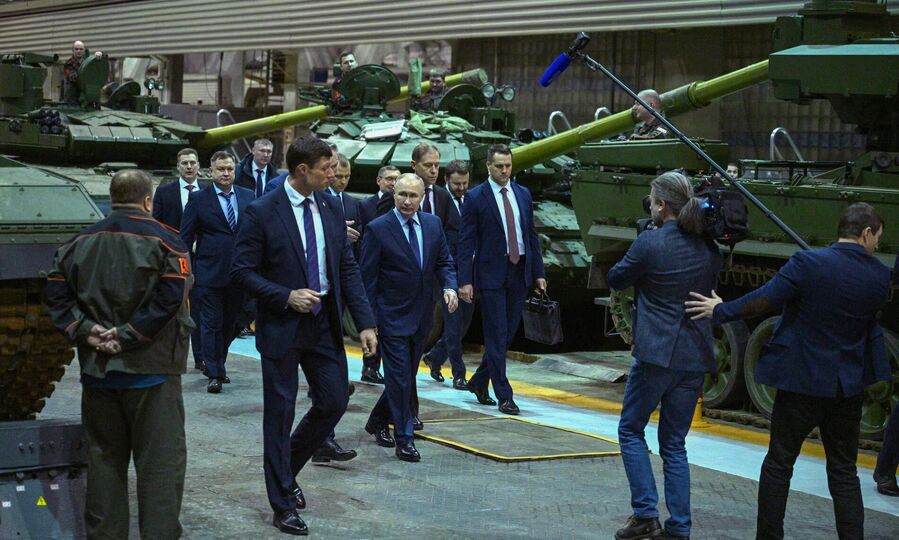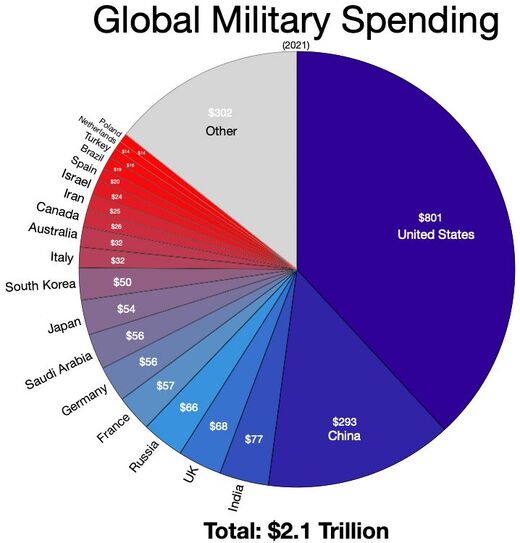
Comment: One must bear in mind that the following article is from notorious propaganda outlet, The Guardian, however what's important here is how, indeed, the establishment's corrupt and inept warmongers weren't prepared for just how coordinated, efficient, and sophisticated, Russia's response to their relentless provocations, and outright attacks, would be. And that they're admitting it is telling.
As Ukraine has scrambled to source ammunition, arms and equipment for its defence, Russia has presided over a massive ramping up of industrial production over the last two years that has outstripped what many western defence planners expected when Vladimir Putin launched his invasion.
Total defence spending has risen to an estimated 7.5% of Russia's GDP, supply chains have been redesigned to secure many key inputs and evade sanctions, and factories producing ammunition, vehicles and equipment are running around the clock, often on mandatory 12-hour shifts with double overtime, in order to sustain the Russian war machine for the foreseeable future.
Comment: A fraction of what the US spends, and which demonstrably gets more bang for its buck.
The transformation has put defence at the centre of Russia's economy. Putin claimed this month that 520,000 new jobs had been created in the military-industrial complex, which now employs an estimated 3.5 million Russians, or 2.5% of the population. Machinists and welders in Russian factories producing war equipment are now making more money than many white-collar managers and lawyers, according to a Moscow Times analysis of Russian labour data in November.
Putin on Thursday visited Uralvagonzavod, the country's largest producer of main battle tanks, where workers boasted that it had been among the first to establish round the clock production. The Russian leader promised funding to help train an additional 1,500 qualified employees for the plant.
As Russia's war in Ukraine drags into its third year, the massive Russian investment in the military, projected this year to be the largest as a share of GDP since the Soviet Union, has worried European war planners, who have said Nato underestimated Russia's ability to sustain a long-term war.
"We still haven't seen where is Russia's breaking point," said Mark Riisik, a deputy director in the policy planning department of Estonia's defence ministry. "Basically one-third of their national budget is going on military production and on the war in Ukraine ... But we don't know when it will actually impact on society. So it's a little bit challenging to say when will this stop."
Comment: Meanwhile the US, UK, and the EU are well past their breaking point, as evidenced by the recent downgrades and recessions.
One key indicator in the artillery war has been the domestic manufacture of shells, which experts put at 2.5m to 5m units a year. Riisik called the trends worrying, noting that production could run above 4m units in the next year or two. The import of more than a million shells already from North Korea, and a strategic stockpile of shells in the millions, gives Russia an additional cushion.
While that number may not give Russia the needed capacity to make significant territorial gains in 2024 or 2025, it nonetheless puts Ukraine at a significant disadvantage on the frontlines, where Russia has at least a three-to-one superiority in artillery fire, and often even more.
"It's a lot higher than we expected, really," Riisik said of the Russian production numbers.
'Kalashnikov economy'
Much of this was baked into Russia's military-industrial complex, a sprawling behemoth of nearly 6,000 companies, many of which rarely turned a profit before the war. But what it lacked in efficiency, it made up for in spare capacity and flexibility when the Russian government suddenly ramped up defence production in 2022.
Comment: For reference, a 2021 pie chart from Wikipedia with military spending by country - which is much the same in terms of ranking as of their data from 2022:
Richard Connolly, an expert on Russia's military and economy at the Royal United Services Institute thinktank in London, called it a "Kalashnikov economy", which he said was "quite unsophisticated but durable, built for large-scale use and for use in conflicts".
Comment: The propaganda media claim Russia is raiding washing machines to keep its military going, and then a year later the White House tells its people to 'not panic' but Russia has some kind of space nuke technology...
He said: "The Russians have been paying for this for years. They've been subsidising the defence industry, and many would have said wasting money for the event that one day they need to be able to scale it up. So it was economically inefficient until 2022, and then suddenly it looks like a very shrewd bit of planning."
That differs significantly from western, especially European, arms manufacturers, who generally run lean operations that work across borders and are designed to maximise profit for shareholders.
Russia can often run its military industry by fiat, reassigning personnel, increasing budgets and filing large orders on an ad hoc basis. Russia will have difficulties sourcing components for more complex weapons such as missiles, especially if sanctions are enforced more strictly. But for now it has managed to continue to supply Iskander ballistic missiles and Kh-101 cruise missiles as well.
Early in 2023, the Russian government transferred more than a dozen plants, including several gunpowder factories, to the state conglomerate Rostec in order to modernise and streamline production of artillery shells and other key elements in the war effort, such as military vehicles.
The Kazan gunpowder plant, one of the country's largest, took on more than 500 workers in a December hiring spree that increased average monthly salaries at the plant more than threefold, from 25,000 roubles (£217) to 90,000 roubles (£782), according to Alexander Livshits, the plant's director. Job adverts offer night shifts from midnight to 8am and protection from military service for those trying to avoid the frontlines.
Many of those hired had to be lured from neighbouring regions, evidence of the severe shortage of skilled labour across Russia. In a twist, the main competition for workers at the factories can come from the military, which promises a salary of more than 200,000 roubles (£1,730) a month to those who sign up to fight in the war.
Comment: Recruitment has been going just fine: Russia to increase troop number to 1.5 million in response 'external threats' - Shoigu
Meanwhile in the US: US military suffers sharp decline in white recruits
In regions across Russia, that kind of money can be transformative. "The war has led to an unprecedented redistribution of wealth, with the poorer classes profiting from government spending on the military-industrial complex," said Denis Volkov, the director of the Levada Center, a polling and sociological research firm in Moscow. "Workers at military factories and families of soldiers fighting in Ukraine suddenly have much more money to spend. Their income has increased dramatically."
Levada's polling showed that 5-6% of those who "previously did not have enough money to buy consumer goods like a fridge now have moved upwards towards the middle classes".
Russia will pay for that by boosting defence spending to nearly 11tn roubles (£95.7bn) next year, a 70% increase, which would surpass social spending for the first time since the Soviet Union.
Comment: Meanwhile the US has been spending more on warmongering for many, many years.
Putin is trying to finance the war, maintain social spending and avoid runaway inflation all at once, in what Alexandra Prokopenko, a Carnegie endowment scholar, calls an "impossible trilemma".
For now, high oil prices are helping to cushion the blow. But the war is set to transform the Russian economy from within.
Comment: Putin's leadership has already transformed the economy. Note also that the West continues to buy 'sanctioned' Russian energy products - albeit paying more through intermediaries.
"In the past, for that whole post-Soviet period, I would have said that oil was the leading sector of the Russian economy," Connolly said. "Now I say it's defence, and oil that will be paying for it. And that poses problems over the longer term."
Round-the-clock production
New analysis by the International Institute for Strategic Studies (IISS) estimates that Russia has lost 3,000 armoured fighting vehicles in the last year and close to 8,800 since the war began.
Unable to produce anywhere near that number of vehicles, Russia has mainly refurbished ageing hardware that Connolly said many other states would have discarded long ago.
Russian factories claimed to have delivered 1,500 main battle tanks this year, of which 1,180 to 1,280 had been reactivated from storage, according to IISS.
Comment: Interestingly, analysts have commented how old soviet equipment is oftentimes superor to modern Western products. Also: if it works, and it's cheaper, why wouldn't Russia just refurbish tanks?
Those numbers, along with reactivated armoured personnel carriers and infantry fighting vehicles, meant Russia would "be able to sustain its assault on Ukraine at current attrition rates for another two to three years, and maybe even longer", the group said.
On the ground, Russian factories have built new production lines and gone on hiring sprees, sometimes looking to forced labour in order to raise production.
Kurganmashzavod, which produces the BMP-2 and BMP-3 infantry fighting vehicles, has brought in student and convict labour in order to help the factory meet its deadlines.
Comment: It's unlikely to be as prolific, or as exploitative, as the US' prison labor.
Dmitry Medvedev, Russia's former president and now the deputy chair of the security council, toured the factory in 2022, and had warned a tank factory about the potential for criminal charges for unfilled state contracts.
Workers told local media they had been shifted to six-day weeks and 12-hour shifts due to Russia's so-called special operation in Ukraine.
One union leader said the new shifts were being enforced under a special order issued by Putin last August that could require workers to work additional time "without their consent", as long as they did not exceed an additional four hours a day.
"Today in Russia practically all military-industrial enterprises with additional state orders are working according to this schedule," Andrei Chekmenyov, the head of the Russian Union of Industrial Workers told the Novye Izvestia newspaper. "It is actually forbidden to refuse additional shifts. You either agree [or] you're fired, and there's no third option."




Reader Comments
to our Newsletter